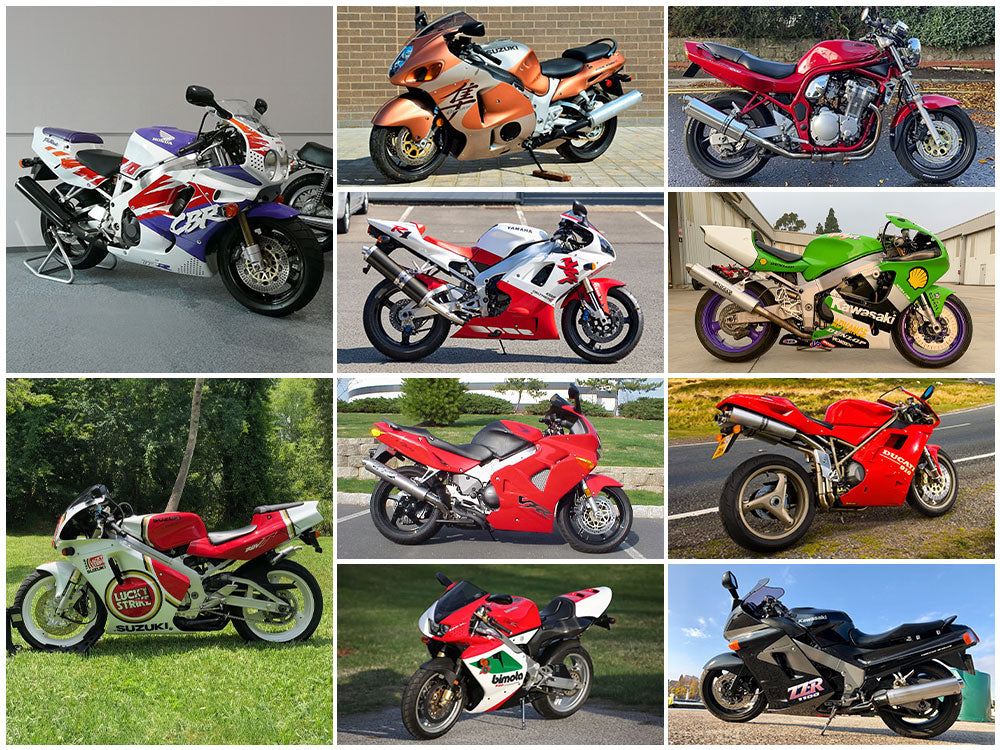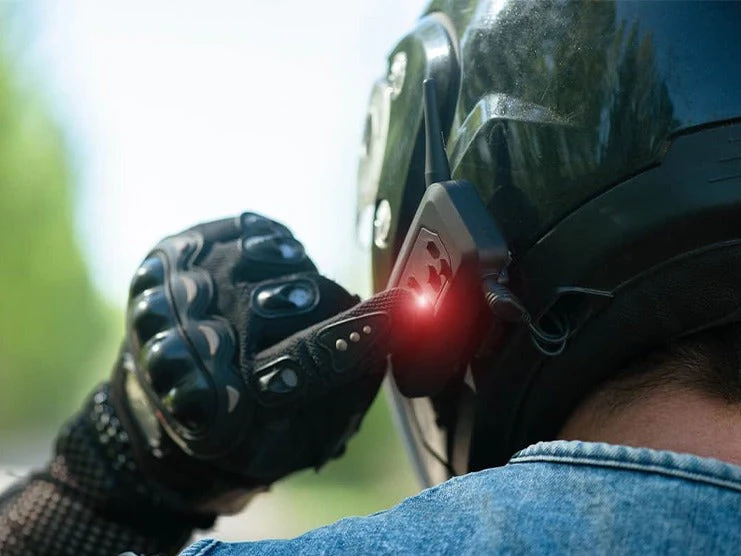The 1990s was a golden age for sportbikes as this was the decade that sportbikes grew in recognition. In 1983, the very first sportbike was created, the HondaVF750F. However, it did not become popular until the 1990s.
Even today, some sports motorcycles from the 1990s are still admired by motorcycle enthusiasts. This article discusses some of the most iconic sports bikes from the 1990s.
Table of Content
1. Suzuki Hayabusa GSX1300R (1999)

Released in 1999, the Suzuki Hayabusa GSX1300R was a sports bike that made quite the impression after its introduction. Capable of a speed between 16-23 km/h, this Suzuki motorcycle broke the early speed record.
The Hayabusa GSX1300R runs on a 1299 cc, four-stroke, liquid-cooled engine with sixteen valves and double-overhead cams.
At the time, it had the biggest displacement of any sports bike, capable of a record-breaking power output of 129 kW.
The Suzuki Hayabusa's high power output at any speed made it easy to ride due to its multiple gears and quick acceleration.
| Engine | Four-Stroke, Transverse Four-Cylinder, DOHC, Four Valves per Cylinder |
| Capacity | 1298 cc |
| Max Power | 175 hp @ 9800 rpm |
| Max Torque | 138 Nm @ 7000 rpm |
| Top Speed | 306 km/h |
| Transmission | Six-Speed |
| Dry Weight | 217 kg |
| Fuel Capacity | 21 L |
| Clutch | Wet, Multiple Discs, Hydraulic Operated |
2. Yamaha YZF-R1 (1998)

In 1998, the Yamaha YZF-R1 was released. The 1998 Yamaha YZF-R1 4XV model had an entirely new design with a stunning look, incredible performance, and competitive handling. Until the early 2000s, this Yamaha model was unopposed as the ideal carburetor-powered sports bike.
The YZF-R1 4XV ran on a 998 cc inline-four cylinder engine capable of horsepower of 140 hp and a torque of 83 lb-ft. After flat slide carbs and race exhausts were installed, the YZF-R1 4XV’s engine became capable of horsepower of 148 hp.
| Engine | Four-Stroke, Transverse Four-Cylinder, DOHC, Five Valves per Cylinder |
| Capacity | 998 cc |
| Max Power | 148 hp @ 10000 rpm |
| Max Torque | 108 Nm @ 8500 rpm |
| Top Speed | 277.2 km/h |
| Transmission | Six-Speed |
| Dry Weight | 192 kg |
| Fuel Capacity | 18 L |
| Clutch | Wet, Multiple Discs, Cable Operated |
3. Honda VFR 800 (1998)

Released in 1998, the Honda VFR distinguished itself from other bikes due to its V4 engine and dual-integrated braking system. The motorcycle is capable of a torque of 82 Nm and a horsepower of 110 hp at 10500 rpm. The VFR 800 is capable of reaching a top speed of 235 km/h.
The Honda VFR's most popular feature was the pleasant noise its engine made.
| Engine | Four-Stroke, Four-Cylinder, 90°, V4 |
| Capacity | 781 cc |
| Max Power | 110 hp @ 10500 rpm |
| Max Torque | 82 Nm @ 8500 rpm |
| Top Speed | 235 km/h |
| Transmission | Six-Speed |
| Dry Weight | 208 kg |
| Fuel Capacity | 20.8 L |
| Clutch | Wet, Multiple Discs, Cable Operated |
4. Bimota V-Due 500 (1997)

The Bimota V-Due 500 was released in 1997, is fitted with a 500 cc two-stroke, V-twin engine. The V-Due 500 became the first two-stroke motorcycle to include an electronically regulated direct fuel injection system. Its other features also included a cassette-type gearbox and a dry clutch. The Bimota V-Due 500 had a higher power-to-weight ratio than nearly all sports motorcycles at the time.
The initial batch of 150 motorcycles in production suffered from oil leaks, malfunctioning pistons, and inconsistent power delivery. After fixing the issues, Bimota managed to sell 26 units in 1999.
| Engine | Two-Stroke, 90°, V-Twin |
| Capacity | 499 cc |
| Max Power | 105 hp @ 9000 rpm |
| Max Torque | 90 Nm @ 8000 rpm |
| Top Speed | 265 km/h |
| Transmission | Six-Speed |
| Dry Weight | 176 kg |
| Fuel Capacity | 20 L |
| Clutch | Dry, Hydraulic Operated |
5. Suzuki Bandit 600 (1995)

In 1995, the Suzuki Bandit 600 was released. This Suzuki model had a GSX600F sport-tourer engine, a basic steel tube frame, a single headlight, no fairing, and all-around standard running gear. Its reliable and fuel-efficient oil-cooled engine could produce a horsepower of 77 bhp.
The non-adjustable front forks were equipped with sliding-caliper twin-piston brakes, while the rear suspension included a monoshock linkage with an adjustable shock absorber.
The Bandit 600 was faster and more efficient than the inline-four vehicles from the 1980s.
| Engine | Four-Stroke, Transverse Four-Cylinder, DOHC, Four Valves per Cylinder |
| Capacity | 599 cc |
| Max Power | 77 hp @ 10400 rpm |
| Max Torque | 54 Nm @ 9500 |
| Top Speed | 206.3 km/h |
| Transmission | Six-Speed |
| Dry Weight | 196 kg |
| Fuel Capacity | 19 L |
Also Read: Sports Motorcycles vs Cruisers
6. Kawasaki ZX-7R (1996)

The Kawasaki ZX-7R was launched in 1996. The ZX-7R’s design was inspired by its predecessor, the ZXR750. However, it had a new 748 cc engine with a shorter stroke, upgraded chassis, and improved bodywork.
For four years after its initial release, the ZX-7R’s original design issues were gradually fixed and improved. This results in a smooth ride with little to no complaints. Unusable mirrors and offering an ergonomically sound cockpit were a couple of the problems Kawasaki addressed throughout the years.
| Engine | Six-Stroke, Transverse Six-Cylinder, DOHC, Four Valves per Cylinder |
| Capacity | 748 cc |
| Max Power | 111.9 hp @ 11700 rpm |
| Max Torque | 75.3 Nm @ 9500 rpm |
| Top Speed | 268.2 km/h |
| Transmission | Six-Speed |
| Dry Weight | 203.4 kg |
| Fuel Capacity | 18 L |
| Clutch | Wet, Multiple Discs, Cable Operated |
7. Ducati 916 (1994)

The Ducati 916 is a fully faired sport bike produced from 1994 to 1998. The Ducati 916 is powered by a 916 cc fuel-injected, four-valve, 90° liquid-cooled V-Twin engine with a single-sided swingarm and USD forks.
The Ducati 916’s has an overall weight of 198 kg, can reach a top speed of 255 km/h, and can achieve a horsepower of slightly over 100 hp.
The Ducati 916 has twin horizontal headlamps, a front fairing, a streamlined frame, a single-sided swingarm, and twin silencers underneath the seat.
British racer Carl Fogarty rode a Ducati 916 and won the WSBK Championship five times during the 1990s. 916 was more difficult and expensive to maintain than more practical equipment, but it was still the most stunning thing to ride on.
| Engine | Six-Stroke, 90° L Twin Cylinder, DOHC, Six Valves per Cylinder, Belt Driven |
| Capacity | 916 cc |
| Max Power | 114 hp @ 9000 rpm |
| Max Torque | 90 Nm @ 7000 rpm |
| Top Speed | 255 km/h |
| Transmission | Six-Speed |
| Dry Weight | 198 kg |
| Fuel Capacity | 17 L |
| Clutch | Dry, Multiplate |
8. Suzuki RGV250M (1992)

The Suzuki RGV250M was released in 1992. The early 1990s was a golden era for sports 250. There were plenty of hot two-stroke 250s available to select from.
The RGV250M proved better than the K and L versions due to having more durable armor.
The Suzuki RGV250M ran on a V-Twin engine that could produce a horsepower of 61 bhp with two-stroke tuners that could increase the power output, but would sharply reduce engine life.
| Engine | Two-Stroke, Two-Cylinder, V-Twin |
| Capacity | 249 cc |
| Max Power | 61 hp @ 11000 rpm |
| Max Torque | 40 Nm @ 8000 rpm |
| Top Speed | 205.4 km/h |
| Transmission | Six-Speed, Constant Mesh |
| Dry Weight | 128.4 kg |
| Fuel Capacity | 17 L |
| Clutch | Wet, Multiplate |
9. Honda CBR900RR FireBlade (1992)

The Honda CBR900RR Fire Blade jumpstarted the sports bike industry during the 1990s. Being far lighter than similar large-displacement bikes, this Honda set the standard for lightweight models in the superbike class.
Though it did not introduce innovative motorcycle technology, the Honda Fire Blade’s design has remained popular to the present day.
Honda selected a 16-inch front wheel to give it an advantage in the handling arena. It was a mix of a lightweight combined with enough power to bring it all to life.
| Engine | Four-Stroke, Transverse Four-Cylinder, DOHC, Four Valve per Cylinder |
| Capacity | 893 cc |
| Max Power | 122 hp @ 10500 rpm |
| Max Torque | 88 Nm @ 10000 rpm |
| Top Speed | 264 km/h |
| Transmission | Six-Speed |
| Dry Weight | 185 kg |
| Fuel Capacity | 18 L |
| Clutch | Wet, Multiple Discs, Cable Operated |
10. Kawasaki ZZ-R1100 (1990)

From 1990 to 2001, Kawasaki produced the ZZ-R1100 or the ZX-11. Until 1996, the Kawasaki ZZ-R1100 was the fastest production motorbike with a top speed of 272-283 km/h.
1990 ZZ-R1100 ran on a 1052 cc engine capable of producing a horsepower of 147 hp. This Kawasaki model had more comfy and plush suspensions and an aluminum frame which reduced its dry weight to 228 kg.
| Engine | Four-Stroke, Transverse Four-Cylinder, DOHC, Four Valves per Cylinder |
| Capacity | 1052 cc |
| Max Power | 147 hp @ 10500 rpm |
| Max Torque | 110 Nm @ 8500 rpm |
| Top Speed | 285 km/h |
| Transmission | Six-Speed |
| Dry Weight | 228 kg |
| Fuel Capacity | 21 L |
| Clutch | Wet, Multi Disc |
11. Last Words
The 1990s was a true golden age for sports motorcycles. From Suzuki to Honda, all the sports bikes discussed were considered great innovations in the motorcycle industry. Motorbikes from the 1990s were aerodynamic, reliable, lightweight, and thrilling. If you wish to improve your sports bike overall look, you can add new luggage like saddlebags, tail bag, backpack, and tank bag.













Leave a comment
All comments are moderated before being published.
This site is protected by hCaptcha and the hCaptcha Privacy Policy and Terms of Service apply.